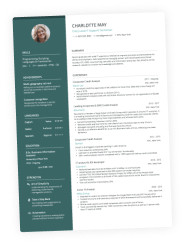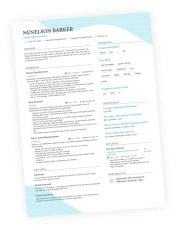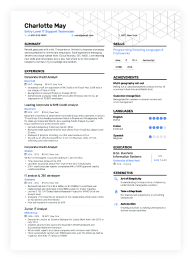You took on a temp job—maybe to pay the bills, gain experience or try out a new field. Now you’re wondering how to list it on your CV without looking like a job hopper.
The good news is employers don’t see temp work as a red flag if you present it strategically. In fact, it can highlight you’re quick to adapt, eager to learn, and capable of thriving in different environments.
This guide will show you how to put temp work on your CV in a way that strengthens your application instead of raising questions.
Let’s dive in.

Key takeaways
- Tailor temp jobs to your target role by focusing on relevant skills and accomplishments.
- Use strong action verbs and quantify results to underline your impact.
- Label positions as temporary to ensure transparency and avoid misinterpretation.
- Include technical skills to optimise for ATS and recruiter searches.
- Maintain consistent formatting so temp roles blend seamlessly into your work history.
What is temporary work—busting common misconceptions
Temporary work refers to short-term roles that help employers cover immediate staffing needs. These placements can last from a few weeks to several months and are often arranged through recruitment agencies or hired directly. Employers bring in temps to manage seasonal peaks, cover staff absences, or trial potential candidates before offering a permanent contract.

A common start for young workers
While the number of temp workers in the UK stands at around 1.56 million, many are younger workers, students, or people returning to the workforce—groups that often value flexibility or short-term experience.
According to the Office for National Statistics, these include individuals aged 16 to 24, who often take on temporary roles to gain work experience or while pursuing education.
Some examples of short-term jobs include:
- A retail sales assistant hired for the holiday season
- A data entry clerk covering for someone on leave
- A warehouse worker brought in to handle a big shipment
- A customer service rep helping during peak business times
For younger people, temporary jobs are often the first step into the world of work—whether that’s in an office, a hospital, a call centre, or a warehouse. They offer practical experience, insight into different industries and a paycheque while you explore your long-term career goals.
Why some people think temp work looks bad on a CV
There’s a lingering belief that employers prefer candidates with long-term, stable jobs on their CVs. Because temp work involves short stints at different companies, some people fear it might look like job-hopping or a lack of commitment. Others assume temporary positions don’t add real value to a CV because they’re not serious roles.
Such thinking ignores what employers actually value today—adaptability, problem-solving, and a willingness to jump into new challenges. Temporary jobs build those skills fast.
Another common misconception is that temp work is a dead-end job—but that’s not necessarily true. If a position is labelled “temp-to-perm” or “temp-to-hire,” there’s a strong chance it could lead to a permanent offer. The key isn’t how others perceive temporary jobs, but rather how well they align with your time, priorities and career goals.

PRO TIP
According to Oriel Partners, many businesses use temp-to-perm roles to assess fit before committing to a long-term hire. Candidates who demonstrate value, build strong relationships and align with company culture are more likely to secure a permanent offer.
Why temp work can be valuable for your CV
If framed correctly, your temporary or seasonal work experience shows that:
- You’re adaptable: You’ve learned new tasks fast and adjusted to different workplaces.
- You’re reliable: Companies hired you because they needed someone who could step in and get the job done.
- You’ve gained real experience: Even short-term roles teach valuable skills like customer service, teamwork, and time management.
Instead of treating temp work as a weakness, think of it as proof of your ability to handle change and make an impact—fast. When you describe it the right way, it can absolutely strengthen your CV.
Now, let’s talk about how to do that.
How to include temporary jobs on your CV
Not every job you’ve ever had belongs on your CV. Only list temporary jobs that are relevant to your current job search. This applies to all jobs, not just temp roles. A CV isn’t meant to be a full record of your work history—it’s a targeted document designed to show why you’re a great fit for a specific job.

PRO TIP
If a temp job gave you skills, experience, or connections that align with your target role, include it. These details serve as essential keywords for applicant tracking systems (ATS)—the software many employers use to manage applications.
An ATS scans CVs for relevant terms. If yours is filled with unrelated jobs or vague descriptions, it might not rank high enough to be seen by a recruiter. So, always highlight relevant temp jobs to boost your chances of passing the ATS screening and landing in front of a hiring manager.
Here’s how to list temporary work on your CV:
Option 1: One or two temp roles (list like other jobs)
If you’ve had just a couple of relevant temporary roles, detail them in reverse chronological order alongside your other work experience.
You can indicate they were temporary by:
- Adding “(Temporary)” next to the job title
- Mentioning it in the job description
- •Boosted Monthly Picks sales by 25% through tailored recommendations and hand-selling strategies.
- •Led a store layout refresh, improving book visibility and increasing customer browsing time by 15%.
- •Helped coordinate and promote three local book events, increasing attendance by 40% month-on-month.
This approach lets you weave short-term roles naturally into your employment history while being transparent about the nature of the work.
Option 2: Multiple temp assignments (group under a recruitment agency)
If you worked through a recruitment agency and held multiple temp jobs, grouping them together keeps your CV clean and easy to read—just like how we frame contract work on a CV.
Instead of listing each short-term role separately, follow this structure to make your experience look intentional and well-organised:
- Title the section “Temporary Work” or similar.
- State the agency as the employer, along with the location.
- Optionally, provide a brief description of your overall duties.
- Break down individual assignments as bullet points under the agency name.
- Include the respective dates for each assignment.
- Highlight key achievements from each role in a concise, impact-driven sentence.
The example below was created using Enhancv’s AI-powered CV builder:
- •Customer Service Representative (Summit Solutions) | 03/2024 – 07/2024 | Handled 50+ customer enquiries daily, raising satisfaction scores by 20%.
- •Administrative Assistant (Westbridge Consulting) | 01/2024 – 02/2024 | Oversaw office coordination and diary management, saving five hours per week.
- •Data Entry Specialist (Horizon Logistics) | 08/2023 – 12/2023 | Entered 1,000+ records weekly with 99% accuracy, improving data reliability in client reporting.
Both approaches keep your CV clean, readable, and focused on relevant experience, so recruiters can quickly see what you bring to the table.
Below is a template you can use to structure the temp work section on your CV, whether you're creating it in MS Word or any other word-processing platform.
[Temporary Work or Recruitment Agency Name]
[Year – Year] | [City]
[Brief description of your responsibilities, optional]
[Your Job Title] [Company Name] | [Start Date] – [End Date]
- [Achievement or responsibility with impact and measurable result.]
- [Optional: Additional bullet showcasing adaptability or collaboration.]
[Your Job Title] [Company Name] | [Start Date] – [End Date]
- [Achievement or responsibility with impact and measurable result.]
- [Optional: Another key contribution that highlights relevant skills.]
How to format temp work on your CV so it looks impressive
If you just list your temp roles with vague job duties, hiring managers (and ATS) won’t see the value. Instead, use strong action verbs, quantify your impact, and underline relevant technical skills.
Let’s recap what you need to know.
Tailor your temp experience to the job you want
The biggest mistake job seekers make is listing temp jobs without tailoring them to the job ad. If you’re applying for a marketing role, your temp work in retail should highlight skills like sales tracking or promotional event support—not just restocking shelves.
Like so:
Customer Service Representative (Temporary)
SMR Agency | March 2024 – July 2024
- Exceeded daily sales targets by 20%, ranking among the top 5 reps in customer conversions.
- Implemented a new ticketing system that reduced response time by 30%.
Label the position as temporary
Temp work isn’t a long-term commitment, so if you don’t clarify that a role was temporary, a potential employer might assume you were fired or quit unexpectedly. Being transparent about the exact duration of your engagement reassures hiring managers that the role had a defined end date—not that you left on bad terms.
Use strong action verbs
Temp roles often involve stepping into fast-paced environments and making an immediate impact. That’s exactly what hiring managers want to see, so make sure you start every bullet point with a strong action verb that reflects what you actually accomplished.
As in:
- Led a team of [number] to streamline [process], improving [result].
- Resolved an average of [X] customer issues per day, increasing [metric].
- Designed a [system/process] that saved [amount of time/money].
- Managed customer escalations, resolving [percent] of issues on first contact.
- Optimised [process], reducing stock discrepancies by [percent].
Quantify your achievements
Numbers prove your impact. Even in temp jobs, you can usually quantify something—how many customers you helped, how much time you saved, or how many orders you processed.
- Before (generic and vague):
“Answered customer calls and helped with issues.”
- After (quantified and results-driven):
“Handled 50+ customer calls daily, maintaining a 98% customer satisfaction score.”
The same goes for transferable skills (abilities that apply to a wide range of jobs). Instead of simply listing them, integrate these skills into your experience bullets to provide context and make them more credible.
Don’t forget technical skills
Even in short-term roles, you’ve likely used industry-specific tools and software—and both hiring managers and ATS systems look for them. Including these in your work history not only amplifies your expertise but also shifts the focus away from the length of the job.
Maintain consistent formatting
To keep your CV professional and easy to read, present temporary roles in the same format as permanent ones. Use consistent font sizes for job titles, company names, and dates to create a polished look. Ensure spacing and alignment are uniform throughout, so your temp work blends seamlessly into your overall work history rather than standing out as an exception.
See how your current CV scores against a real ATS with our free CV Checker.
Is your CV good enough?
Drop your CV here or choose a file. PDF & DOCX only. Max 2MB file size.
Three mistakes to avoid when putting temp jobs on a CV
Temporary jobs can enhance your CV but only if they’re presented the right way. Avoid these common mistakes that can make your temp work look unstructured, misleading, or irrelevant.
Omitting temporary roles
Leaving temp work off your CV can create unexplained employment gaps, which may cause concern for hiring managers. Even if a temp job was short-term, it still counts as experience, especially if it gave you relevant skills.
So, skip a temp position only if it’s unrelated to your career path or you have stronger experience to showcase.
Misrepresenting the nature of employment
Never stretch the truth to make a temp job look like a permanent one. Transparency matters, and hiring managers can easily verify employment history. If a role was temporary, label it as such—whether in the job title or description.
Here are your options:
- Job title: “Administrative Assistant (Temporary)”
- Under the company name: “Mercury Recruitment Agency – Various Assignments”
- In the description: “Short-term role supporting [specific project or coverage].”
Overloading with irrelevant details
Just because you worked a temp job doesn’t mean every detail belongs on your CV. A cluttered work history filled with unrelated responsibilities can make your CV hard to scan and less effective.
Generic job duties don’t add value to your application. Instead, focus on:
- Achievements, not just tasks (e.g., “Increased order accuracy by 20%” instead of “Processed orders”).
- Skills that transfer to your target job (customer service, teamwork, software knowledge).
- Measurable results whenever possible.
Hiring managers spend seconds scanning a CV. Keep your temp job descriptions concise, relevant, and achievement-focused to make the best impression.
Frequently asked questions about temp work on a CV
Still unsure about how to handle temporary jobs on your CV? Here are answers to some of the most common questions job seekers have.
Should I put a three-month job on my CV?
Yes, if it’s relevant to the job you’re applying for or helps fill an employment gap. A short-term role can showcase valuable skills, so focus on achievements rather than the duration. If the job was unrelated to your career path and you have stronger experience to highlight, it’s okay to leave it off.
How do I list seasonal work on my CV?
Label it clearly to show that it was a seasonal position and not a job you left early. You can add “(Seasonal)” next to the job title or explain it in the description.
For example:
Retail Assistant (Seasonal)
Asda | November 2023 – January 2024
What’s a better word for a temp worker?
Instead of “temp worker,” try “Temporary [Job Title],” “Contract [Job Title],” or simply the actual job title with “(Temporary)” in parentheses. If you worked through an agency, listing “Staffing Agency Assignments” can also sound more professional.
How do I apply for temporary work in the UK?
To apply for temporary work in the UK, you can register with recruitment agencies, search job boards like Indeed, Reed, or Totaljobs, or apply directly through company websites. You'll typically need an up-to-date CV and, if you're not a UK citizen, the right to work in the UK. Temp roles often move quickly, so be ready to interview and start at short notice.
Conclusion
When presented strategically, temporary work can be a significant asset on your CV, underscoring a diverse skill set and a proactive approach to career development. So, approach your CV as a dynamic document that tells your unique career story, with temporary roles contributing valuable chapters.



